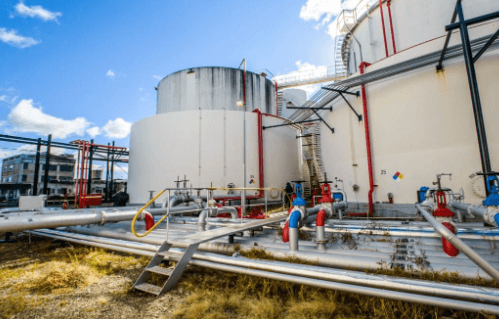Sti Sp001: Understanding The Inspection Requirements For Aboveground Tanks

If you are in charge of maintaining aboveground tanks, then understanding the inspection requirements outlined in STI SP001 is crucial. This standard has been developed by the Steel Tank Institute as a set of guidelines for inspecting and maintaining aboveground storage tanks. By following these guidelines, you can ensure that your tanks are safe, reliable, and compliant with industry regulations.
To begin with, it’s important to note that STI SP001 covers a wide range of topics related to tank inspections. These include qualifications and training requirements for inspectors, inspection procedures, repair and alteration guidelines, and compliance and record-keeping protocols.
As such, familiarizing yourself with this standard will require some time and effort on your part. However, by doing so you can gain peace of mind knowing that your tanks are being properly maintained and inspected according to industry best practices.
Key Takeaways
– STI SP001 provides guidelines for inspecting and maintaining aboveground storage tanks to ensure safety, reliability, and compliance with regulations.
– Becoming an STI SP001 inspector requires a minimum of three years of experience in tank inspection or related field with hands-on experience.
– Inspection procedures involve careful examination of the tank’s exterior and interior surfaces using non-destructive testing techniques to identify issues before they become major problems.
– Repair and alteration must follow industry standards and regulations for safety and effectiveness, with proper communication among all parties involved, and diligent record-keeping to ensure compliance and safety.
Overview of STI SP001
Hey, did you know that understanding the basics of STI SP001 is crucial for maintaining aboveground tanks? Let’s take a look at what it entails.
The Steel Tank Institute Standard for Inspection of Aboveground Storage Tanks (STI SP001) sets the industry standard for inspection and maintenance requirements. This standard provides guidelines for inspecting shop-fabricated and field-erected aboveground storage tanks to ensure they are safe, reliable, and compliant with regulations.
The benefits of complying with STI SP001 are significant. Regular inspections can identify issues before they become major problems, leading to reduced maintenance costs, improved safety, and increased uptime. By following the guidelines set out in this standard, owners and operators can be confident that their tanks will meet regulatory requirements while minimizing risk to personnel or the environment.
Understanding these benefits underscores the importance of adhering to STI SP001 guidelines when inspecting aboveground storage tanks. Now let’s explore the qualifications and training requirements needed by inspectors to perform these inspections effectively.
Qualifications and Training Requirements for Inspectors
To become an STI SP001 inspector, you’ll need to meet certain qualifications and training requirements. Familiarity with the STI SP001 inspection requirements is essential to ensure compliance and accuracy during the inspection process.
These include completing the Inspector Certification Program offered by the Steel Tank Institute. You’ll also need to have a minimum of three years of experience in tank inspection or a related field.
Additionally, you must be able to demonstrate knowledge of industry standards and regulations related to aboveground storage tanks.
Inspector Certification Program
The Inspector Certification Program is a valuable resource for those looking to ensure their aboveground tanks are meeting all necessary inspection requirements. This certification process was developed in response to industry standards that require inspectors to possess the proper knowledge and skills for safe and effective inspections.
By participating in this program, you can gain the necessary skills and knowledge needed to become a certified inspector of aboveground tanks. The program includes both classroom instruction and hands-on training, providing participants with a comprehensive understanding of tank inspection procedures, as well as practical experience using industry-standard equipment.
Additionally, the program offers ongoing education opportunities for certified inspectors to stay up-to-date with any changes or updates in inspection requirements. With this certification, you can help ensure that your facility’s aboveground tanks meet all necessary safety regulations.
It is important to note that while certification is an important component of becoming an inspector of aboveground tanks, it is not the only requirement. Experience working with tanks and related equipment is also critical in ensuring that inspections are conducted safely and effectively.
Experience Requirements
You’ll need some hands-on experience working with tank equipment to become a qualified inspector. This means having practical knowledge of the industry and its operations, as well as familiarity with the specific types of tanks you will be inspecting. Hands-on training is essential for developing the skills necessary to identify potential issues and evaluate the condition of aboveground tanks.
Industry knowledge is also important when it comes to understanding regulations and standards that must be followed during inspections. The STI SP001 certification program requires candidates to have at least two years of experience in tank fabrication, inspection, or related fields before becoming a certified inspector. This ensures that inspectors are equipped with the necessary knowledge and skills to perform thorough inspections that meet industry standards.
To transition into the subsequent section about inspection procedures, it’s important to note that once you’ve gained the necessary experience and industry knowledge required for certification, you can move on to learning about inspection procedures themselves. These procedures specify how inspections should be conducted in order to ensure safety and compliance with regulations. Understanding these inspection procedures is crucial for performing accurate and effective inspections on aboveground tanks.
Inspection Procedures
Inspection procedures for aboveground tanks involve careful examination of the tank’s exterior and interior surfaces. Inspection frequency is dependent on several factors, including the type of product stored in the tank, tank size, and local regulatory requirements. Non-destructive testing techniques are commonly used during inspections to evaluate the structural integrity of the tank without causing damage.
During an inspection, the inspector will thoroughly examine all areas of the tank for signs of wear and tear, corrosion, cracks, or other damage. This includes inspecting welds, seams, fittings, and valves. If any issues are identified during an inspection, they must be addressed promptly to prevent further deterioration or potential failure of the tank.
With a clear understanding of proper inspection procedures and techniques, you can ensure that your aboveground tanks remain safe and reliable for many years to come.
When it comes to repairing or altering aboveground storage tanks, it’s important to follow industry standards and regulations to ensure that work is done safely and effectively. Proper communication between all parties involved in repair or alteration projects is essential to ensure that work is completed efficiently while maintaining high safety standards.
Repair, Alteration and Reconstruction of Tanks
When it comes to repairing, altering, or reconstructing aboveground tanks, you must follow certain criteria to ensure the safety and integrity of the tank. This includes complying with specific requirements for repairs and alterations, as well as meeting standards for reconstruction.
Failure to adhere to these criteria could result in serious consequences, including leaks or structural failure. As you embark on any repair, alteration, or reconstruction project involving aboveground tanks, be sure to carefully review these criteria and requirements before beginning any work.
Criteria for Repairs
If your aboveground tank needs repairs, it’s important to understand the criteria for those repairs. These criteria are meant to ensure that your tank is safe and functional, and that it will continue to be so after the repair work is complete. Here are four things you should keep in mind when considering repairs for your aboveground tank:
1. Cause analysis: Before making any repairs, it’s important to determine what caused the issue in the first place. This will help you make targeted repairs that address the root cause of the problem rather than just patching over a symptom.
2. Preventive maintenance: Regular inspections and maintenance can help prevent issues from occurring in the first place, reducing the need for major repairs down the line.
3. Compliance with industry standards: Any repair work must comply with relevant industry standards such as STI SP001 and API 653.
4. Qualified personnel: Repairs should only be carried out by qualified professionals who have experience working with aboveground tanks.
Understanding these criteria can help you make informed decisions about repairing your aboveground tank, ensuring that it remains safe and functional for years to come.
As you consider alterations or reconstruction requirements, keep in mind how they may impact future repair needs and adhere to best practices outlined by regulatory bodies such as STI SP001 or API 653 guidelines for compliance purposes.
Alteration and Reconstruction Requirements
To ensure the long-term safety and functionality of your tank, it’s essential to adhere to industry standards and work with qualified professionals when making alterations or reconstruction. Altered tanks require careful consideration due to their potential risks and hazards. It’s imperative that you follow the appropriate reconstruction guidelines outlined in STI SP001 to avoid accidents, spills, or leaks.
When planning for alteration or reconstruction, it’s important to seek professional advice from experts who understand the requirements set forth by STI. These guidelines outline specific criteria for inspection and testing before any alterations can be made. In addition, they provide a framework for ensuring that all necessary repairs are completed correctly.
Failure to comply with these guidelines could result in costly fines or legal action against your company. With proper adherence to these regulations, you can maintain a safe working environment while ensuring that your tank remains compliant with industry standards.
Now let’s move on to understanding compliance and record-keeping requirements for aboveground tanks.
Compliance and Record-Keeping
You’ll need to keep thorough records of inspections and maintenance in order to stay compliant with STI SP001 regulations. The regulation requires that all inspection reports be kept on file for a minimum of three years, which includes both routine and formal inspections. These records should include information such as the date of the inspection, who performed it, what was inspected, any deficiencies found, and how they were addressed.
In addition to inspection records, you’ll also need to maintain accurate documentation of any repairs or alterations made to your aboveground tanks. This includes keeping detailed records of equipment replacement and upgrades, including materials used and installation dates.
By maintaining these records diligently, you can demonstrate compliance with STI SP001 regulations during an audit or inspection. Remember that record-keeping is not only required by regulation but is also essential for ensuring the safety and longevity of your aboveground tanks.
Conclusion
In conclusion, it’s crucial to understand the inspection requirements for aboveground tanks. This ensures a safe and efficient storage system for various liquids. The STI SP001 standard provides comprehensive guidelines covering qualifications and training requirements for inspectors, inspection procedures, repair, alteration, and reconstruction of tanks, compliance, and record-keeping.
To ensure compliance with safety regulations and maintain the highest standards possible, it’s essential to engage experienced inspectors knowledgeable about the STI SP001 standard. By following these guidelines closely, you can ensure your tank remains in good condition for years to come.
Remember to keep accurate records of all inspections and any repairs or alterations made to the tank. This facilitates easy maintenance and compliance checks.




